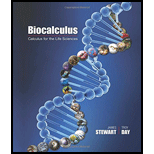
Biocalculus
15th Edition
ISBN: 9781133109631
Author: Stewart, JAMES, Day, Troy
Publisher: Cengage Learning,
expand_more
expand_more
format_list_bulleted
Concept explainers
Question
Chapter 10.3, Problem 9E
(a)
To determine
To Find: The form of the system of differential equations and the assumptions underlie them.
(b)
To determine
To Find: The homogeneous system obtained using change of variables.
(c)
To determine
To Find: The general solution of the system obtained in previous part.
(d)
To determine
To Find: The solution of the original initial value problem with initial conditions
Expert Solution & Answer
Want to see the full answer?
Check out a sample textbook solution
Students have asked these similar questions
5:38
Video Message
instructor
Submit Question
|||
D
8:38
***
TEMU
TEMU
-3
-2
7
B
2
1
& 5G. 61%
1
2
-1
Based on the graph above, determine
the amplitude, period, midline, and
equation of the function. Use f(x) as
the output.
Amplitude:
2
Period: 2
Midline:
2
☑ syntax
error: this is not an equation.
Function:
f(x) = −2 cos(πx + 2.5π) +2×
Question Help: Worked Example 1 ☑
Message instructor
Submit Question
|||
<
8:39
***
TEMU
5G 60%
A ferris wheel is 28 meters in diameter
and boarded from a platform that is 2
meters above the ground. The six
o'clock position on the ferris wheel is
level with the loading platform. The
wheel completes 1 full revolution in 4
minutes. The function h = f(t) gives
your height in meters above the
ground t minutes after the wheel
begins to turn.
What is the amplitude?
14
meters
What is the equation of the Midline?
y = 16
What is the period?
4
meters
minutes
The equation that models the height
of the ferris wheel after t minutes is:
f(t):
=
ƒ (3) = ·−14(0) + 16
syntax error: you gave an equation,
not an expression. syntax error. Check
your variables - you might be using an
incorrect one.
How high are you off of the ground
after 3 minutes? Round your answe
the nearest meter.
|||
<
Chapter 10 Solutions
Biocalculus
Ch. 10.1 - Prob. 12ECh. 10.2 - Prob. 5ECh. 10.2 - Prob. 38ECh. 10.2 - Prob. 39ECh. 10.3 - Prob. 3ECh. 10.3 - Prob. 5ECh. 10.3 - Prob. 9ECh. 10.4 - Prob. 1ECh. 10.4 - Prob. 12ECh. 10.4 - Prob. 15E
Ch. 10.4 - Prob. 26ECh. 10.4 - Prob. 27ECh. 10.4 - Prob. 28ECh. 10.4 - Prob. 29ECh. 10.4 - Prob. 30ECh. 10.4 - Prob. 31ECh. 10.4 - Prob. 32ECh. 10.4 - Prob. 33ECh. 10.4 - Prob. 34ECh. 10.4 - Prob. 35ECh. 10 - Prob. 1CCCh. 10 - Prob. 2CCCh. 10 - Prob. 3CCCh. 10 - Prob. 4CCCh. 10 - Prob. 3TFQCh. 10 - Prob. 1ECh. 10 - Prob. 2ECh. 10 - Prob. 3ECh. 10 - Prob. 4ECh. 10 - Prob. 5ECh. 10 - Prob. 6ECh. 10 - Prob. 7ECh. 10 - Prob. 14ECh. 10 - Prob. 15ECh. 10 - Prob. 16ECh. 10 - Prob. 17ECh. 10 - Prob. 27ECh. 10 - Prob. 28ECh. 10 - Prob. 29E
Knowledge Booster
Learn more about
Need a deep-dive on the concept behind this application? Look no further. Learn more about this topic, calculus and related others by exploring similar questions and additional content below.Similar questions
- Use Laplace transform to find L{f(t)} f(t) = tsin(t)arrow_forward√3/2 1 √1-x2 arcsinx 1/2 dx = 2arrow_forwardThe evolution of a population of Hippos, R(t), in hundreds, time in years, in an African National Park is given by the equation, dR dt (a) Solve the system exactly for R(t). = R(7 – R); R(0) = 3 2 (b) What happens as the time t → ∞o, i.e. what is the population a long time in the future? (c) Write an Euler scheme and compute until the population levels off (using Excel, Matlab, Octave, LibreCalc or similar). Do it twice, once with At = 0.1 and once with At = 0.05. (d) Plot all of your solutions on the same set of axes and comment.arrow_forward
- find For triangle ABC, with vertices A = (3,-1,2), B = (-5,4,-4) and C = (6, −1, −1), (a) the length of side AB, (b) the equation of the line that passes through A and B, (c) the angle at vertex B, (d) a vector perpendicular to the plane containing the triangle ABC, (e) the area of the triangle ABC. (f) the equation of a plane passing through A, B and C.arrow_forwardShowing all working, use the row reduction method to find the inverse of B, given by 5 -1 B = -3 1 3 1 -3 2arrow_forwardConsider the matrix A, given by +63) A = 1 -3 4 -3 4 5 -105 (a) Find the determinant of the matrix, A. (b) Find all possible solutions, x, to the system Ax = b, where b is the column vector, (1,2, −4).arrow_forward
- If a (1,4,2) and b = (−1, −5,3), find |a|, a + b, 3a - 2b, a b, a x b and b × a. What is the angle between a and b?arrow_forwardShowing all working, find the eigenvalues and corresponding eigenvectors of -3 (a) (27) 6arrow_forwardShowing all working and using row operations determine all solutions to the follow- ing system of equations. 2x + 3y-2z = 8, -2x+y+6z= 12, -x+3y-2z = −4.arrow_forward
arrow_back_ios
SEE MORE QUESTIONS
arrow_forward_ios
Recommended textbooks for you
- Algebra & Trigonometry with Analytic GeometryAlgebraISBN:9781133382119Author:SwokowskiPublisher:Cengage

Algebra & Trigonometry with Analytic Geometry
Algebra
ISBN:9781133382119
Author:Swokowski
Publisher:Cengage
01 - What Is A Differential Equation in Calculus? Learn to Solve Ordinary Differential Equations.; Author: Math and Science;https://www.youtube.com/watch?v=K80YEHQpx9g;License: Standard YouTube License, CC-BY
Higher Order Differential Equation with constant coefficient (GATE) (Part 1) l GATE 2018; Author: GATE Lectures by Dishank;https://www.youtube.com/watch?v=ODxP7BbqAjA;License: Standard YouTube License, CC-BY
Solution of Differential Equations and Initial Value Problems; Author: Jefril Amboy;https://www.youtube.com/watch?v=Q68sk7XS-dc;License: Standard YouTube License, CC-BY